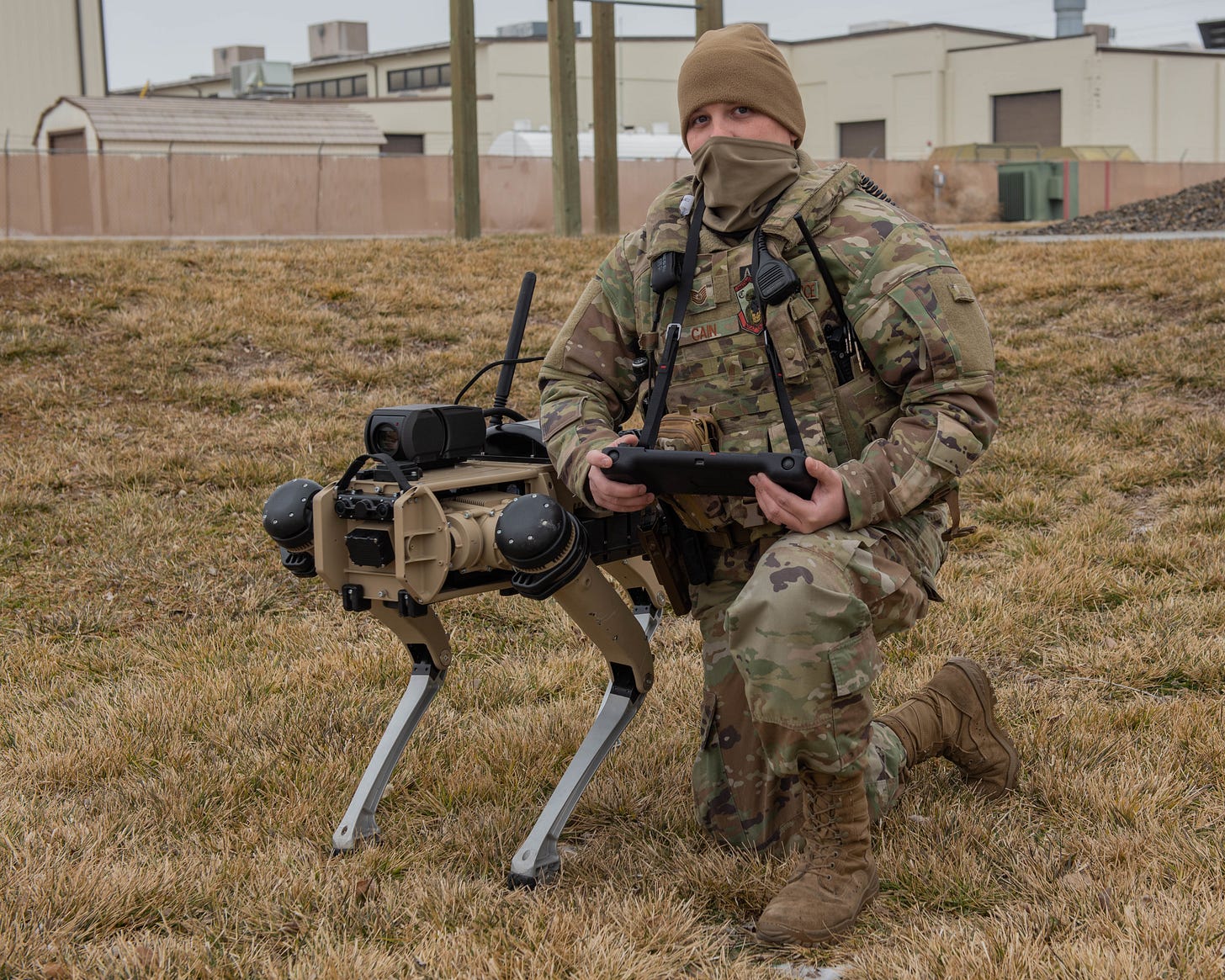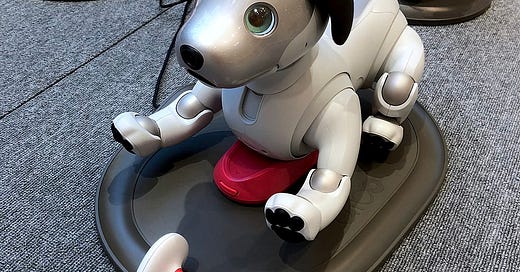Funeral Rituals For Robot Dogs
Humans at war will inscribe meaning into the deaths of battlefield companion machines. We already do it for animals.
Edited by Althea May Atherton
In 2015, I was paid $84 to write a story that would ricochet seven years into the future and haunt my past week. “In Japan, A Funeral For Robot Dogs,” published February 28, 2015, was a deviation from my more familiar, narrowly honed beat of war and war machines, but it fell into the broader era of blogging as aggregation, provided there was some value to add. In this instance, the value was also the reason I pitched it: Alymay and I had, just days prior, adopted Stella, our first dog together. The story, at the very end, contains a picture taken by Alymay of me and our 11-week-old puppy.
Stella passed January 25th. I’ve written about our loss at length and with vulnerability elsewhere. For Wars of Future Past, I am specifically discussing what brings people to extend that same kind of sympathy to robot dogs, and what it means for war when we treat robots like living beings.
My 2015 story aggregates the Digital Trends story “This robot dog funeral may be the saddest thing you see today,” itself aggregated from a gallery at the Wall Street Journal, built around a gallery of images taken by photographer Toshifumi Kitamura and licensed from Agence France-Presse/Getty Images. The images are of mourning rituals for companion robots.
Here is how the funeral is described in the Wall Street Journal version:
Engineers of A FUN, a company that repairs Sony’s Aibo robot dogs, hold “dead” Aibo prior to their funeral at a temple in Chiba, east of Tokyo, on Jan. 26. Like organ donors, parts of some Aibo are used to fix others, as Sony discontinued maintenance on the robots last year.
In my version, published the better part of a decade ago, I emphasize the specific relationship between the people kept company by companion machines:
In a study, elderly people who interacted with Aibo were shown to have similar beneficial health effects to those who played with real living dogs. With life-imitating machines part of people’s lives, it’s no wonder that their imitation deaths draw funerals.
Funerary rituals are, ultimately, about the relationship of the people performing the ritual to that which they are mourning. There is a tremendous deal of complexity in this, especially when it comes to the expressed wishes of dead humans and the myriad belief and cultural systems that inscribe meaning after life. When mourning machines, non-sentient amalgams of metal, plastic, and code, we can bypass deeper questions of religious truth and focus narrowly, instead, on why the mourners mourn.
“Bungen Oi, head priest at the Kofukuji temple, says the the funeral allows the robots’ souls to pass from their bodies,” records the Journal, in a line that I wish was given a dozen follow-ups about the souls of robot pets and how they manifest after life.
The robotic companions in the gallery are identified with tags showing family name and address, and scavenging parts from completely nonfunctioning robots to repair other machines is analogized to organ transplant. This medical and religious language, paired with the actual ritual of the funeral, says a great deal about what it means to lose a robot companion.
Losing a companion robot must be a profoundly lonely experience.
There is the cold comfort that robot companions, unlike living beings, are incapable of feeling pain, and so do not suffer as their systems fail and ultimately falter as mortal pets do. Despite this, it is the profoundly human desire to read feelings into machines that likely necessitates this ritual. It is hard not to read the failing of mechanical limbs, or the dimming of electronic eyes, as direct analogs to the aging and faltering of a living animal.
Reading compassion into an imitation of a companion animal is part of what makes the robot dogs of war so unsettling.
Before four-legged robots became a focus of military research around 2006, companion robots like Aibo were the most prominent expression of the form. In an era of abundant and novel consumer electronics, it is easy to see why: even a cartoonish semblance of an actual dog is likely enough to ease the monotony and loneliness of daily life.
When I write about military adaptations of commercial technologies, I often describe it as “dual-use,” with the idea that utility in one area precedes adaptation in another. Dogs, living, breathing animals, are hard to describe as “technology,” though “domestication” frequently shows up as a technology option in video games. Protective gear for dogs, like goggles for safety when working, have been adopted by animals in military service. The use of animals in war is downstream, as it has been for millennia, from the use of animals in other parts of life.
Ancient history records dogs used for war by at least 600 BCE. The earliest fossil evidence of a domesticated dog dates back to at least 14,000 BCE, predating military usage by tens of thousands of years. It is unlikely that that entire span of prehistory saw no violence by dogs authored by people, but I think it still speaks to the general reality that people’s foremost association of dogs is companionship, which makes using dogs as weapons feel like a perversion.

There is no direct lineage between the Aibos robot funerals and the Big Dogs, Spots, or Vision 60 Q-UGVs of battlefields and police patrols. Arriving at a four-legged form and branding it as a dog is a convergent design for companions and weapons. But because humans see the form and the function of a legged robot as fundamentally similar to that of a companion animal, it is highly likely that on a future battlefield, people will respond to the loss of functioning in a robot the same way they respond to the loss of a beloved pet.
As cautionary tales based on reported events, the stick-bug mine-sweeping robot is foundational. I first encountered the story in technologist Peter W. Singer’s 2009 book Wired for War; the original reporting comes from journalist Joel Garreau for The Washington Post in 2007. There’s a version of it in The New Breed, a 2021 book by robot ethics researcher Kate Darling, which examines how humanity’s history with animals contours our future with robots.
The stick-bug minesweeper was a robot built by researchers at Los Alamos National Laboratories and tested at Yuma Proving Grounds in Arizona. As designed and tested, it would find buried explosives, crawl to put a leg on the bomb, and then scamper forward to destory another mine, one limb fewer each time, until it had expended all its legs. The sight, as reported by Garreau, was enough for an Army colonel to call the whole enterprise inhumane.

To the best of my knowledge, a robot that deliberately and repeatedly seeks out explosives to detonate with its body was never fielded or deployed by the US military. Other robots, often used as scouts with the expectation of returning home, became the subject of military rescue missions, funerary salutes, and the same kind of attachment given to living beings.
Darling analogizes this impulse to a story of how, in World War I, conscripted soldiers who had never worked with horses before the war found themselves so attached to their animals that they repeatedly risked and suffered injury in attempts to rescue animals trapped in a burning building.
“While the goal of this book is to reframe the robot-human analogy, it’s important to understand that we will treat robots like living things. Our tendency runs deep, and as much as we could decry it and argue against it, it’s not going away,” writes Darling.
This is true in social contexts, as a new generation of Aibo companion robots heralds not just a future of robot funerals, but one where those funerals will likely be delayed by the purchase of sustainment plans to keep animating the robot. And it means a belief I’ve long held, that the loss of a drone to enemy fire is unlikely to escalate a war, needs revisiting.
“We haven’t given people’s ability to relate to robots the serious consideration it will increasingly require,” writes Darling. “This means that we’re deploying robots in tool contexts without understanding that people may treat them differently than other devices, without considering when that might happen, why, and how to deal with it when it does.”
In 2015, as I was blogging about a funeral for robots while a living puppy bounced around our small DC apartment, the entire ritual seemed grim, haunting, and out of fiction. I explicitly called it “a scene drawn from cyberpunk fever-dreams,” which is true inasmuch as that specific genre treated modern people in modern Japan as both a mixture of archaic and futuristic.
In the nearly seven years since, even given the bleak confines of my chosen beat, I’ve observed instead that people inscribe a tremendous amount of meaning into beings they do not fully understand, but rely on regardless.
Death rituals are a way we make sense of the world around us, and formally acknowledge the harsh rupture in our lives that delineates a before and after in the name of a being.
This newsletter is no different.

Thank you all for reading. It has been, mildly, a rough month. Knowing I have an audience and a forum to work through not just the reporting but the feelings about reporting on my beat is invaluable. I truly feel like a more well-rounded writer because your support gives me the freedom to do work like this.
I am continuing to contribute to Discontents, where recent newsletters have touched on everything from the failure of securitizing illness to demonizing transplant recipients.
In addition, if you have followed our mourning of Stella in public and feel so inclined, you can donate to the Animal Humane of Española in her honor. That shelter serves much of northern New Mexico, and took care of Stella’s beloved cats, Wicket and Momo, prior to their adoption.




